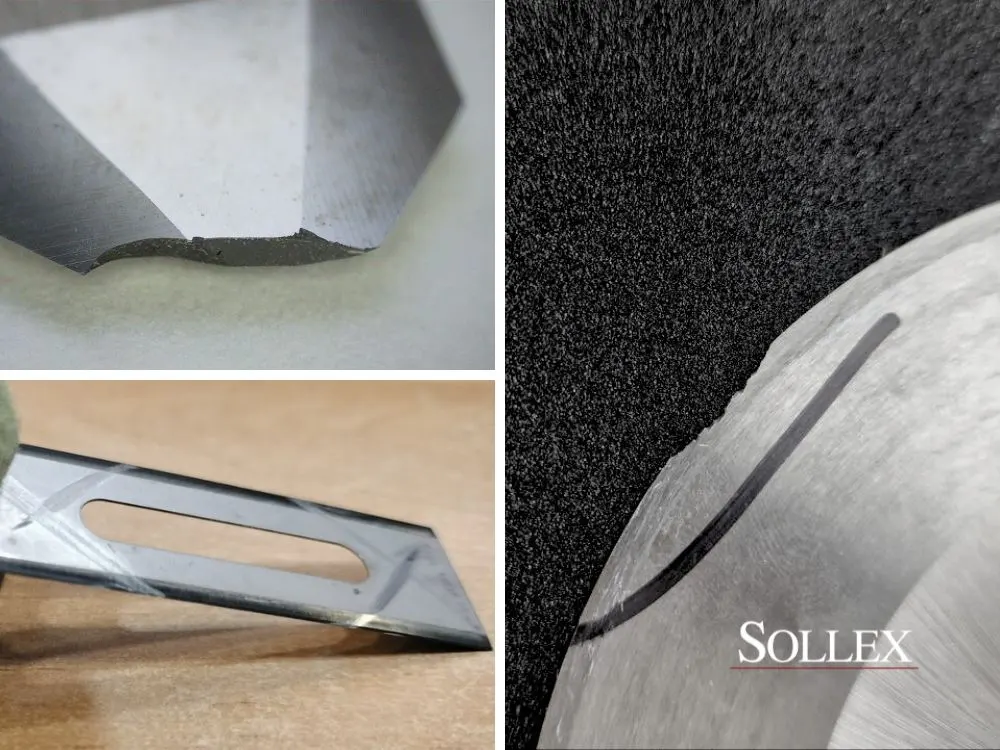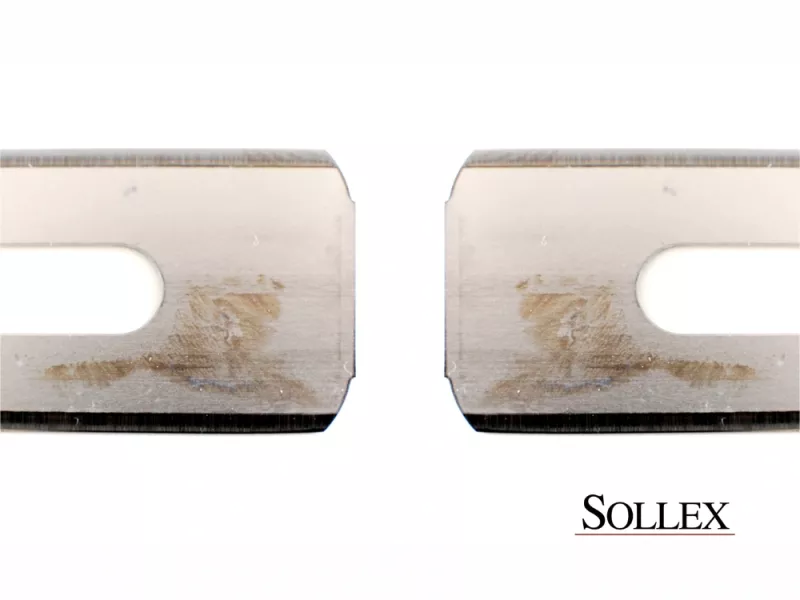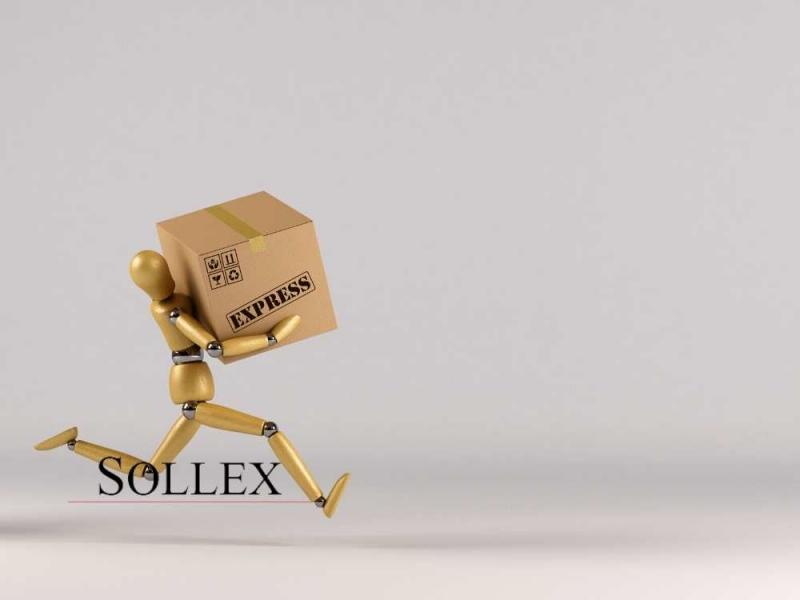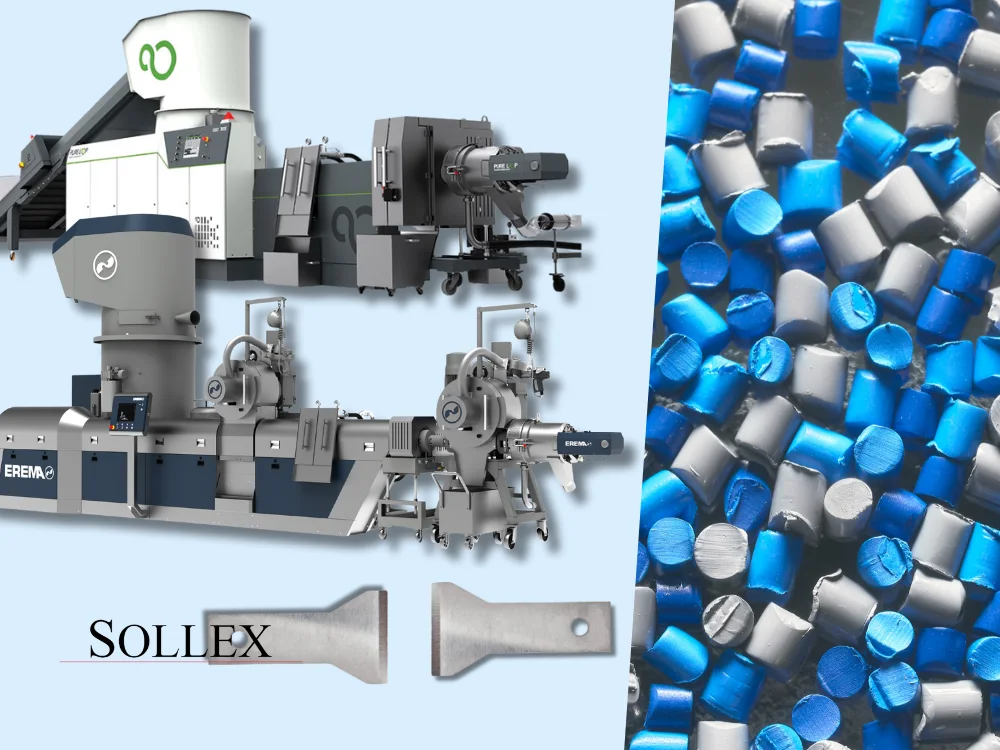6 Reasons Why Your Blades Wear Out Fast
Why do machine knives and slitting blades wear out too fast? In every converting line, blade wear is expected, but excessive or premature wear is a signal of wrong setup, poor blade choice, or unsuitable material conditions. Frequent replacements increase downtime, cost, and waste. In this article, Sollex explains the six most common reasons why industrial blades fail early, with practical advice on how to extend their service life.
Reasons Why Industrial Blades Can Wear Out Too Soon
Whether you’re converting plastic film, foam, fiber-reinforced composites, or other demanding materials, replacing slitting knives too often can lead to downtime, higher operating costs, and inconsistent results.
Understanding why your industrial blades wear out quickly and how to prevent it can make a significant difference in both productivity and profit. In this article, we’ll explore the most common reasons for accelerated machine knife wear. We'll provide you with helpful advice on how to prolong the life of your cutting tools in the upcoming post “How to Prevent Fast Blade Wear & Tear”.
Is your blade material right for the substrate?
 One of the most common causes of accelerated wear and tear is the use of standard tool steel blades in demanding applications. Cutting abrasive or composite materials, such as glass-fiber-reinforced plastics (GFRP), aluminum composite panels (ACP), or recycled polymer plastic films, can quickly dull such machine blades.
One of the most common causes of accelerated wear and tear is the use of standard tool steel blades in demanding applications. Cutting abrasive or composite materials, such as glass-fiber-reinforced plastics (GFRP), aluminum composite panels (ACP), or recycled polymer plastic films, can quickly dull such machine blades.
For slitting abrasive and tough materials solid tungsten carbide, coated cutting-edge knives ( e.g. ceramic or zero-friction coated blades ) offer far greater resistance to abrasion and thermal fatigue. Material selection should be based on both substrate characteristics and cutting environment (e.g. dry vs. lubricated, high vs. low temperature). Standard tool steel blades cutting calcium carbonate-filled PE films may dull within minutes, while ceramic-coated Sollex blades last up to 5–8× longer.
Can poor manufacturing shorten blade life?
Blades produced with inadequate hardening, poor surface finishing, or inconsistent tolerances degrade faster even when geometrically correct. Look for blades with controlled heat treatment processes, precise edge grinding, and surface coatings or polishing that enhance wear resistance and reduce friction.
How does edge geometry influence blade wear?
 Even a high-quality converting knife can wear out prematurely if it has the wrong design not adapted for your application. Blade geometry, including sharpening bevel, edge thickness, and tip radius, directly influences cut quality and wear resistance. A blade with too steep bevel may produce a sharp cut initially but will dull faster under high load. Conversely, a thicker edge increases durability but may require more force and generate heat. Optimizing the edge profile for the specific material type and cutting method (razor slitting, shearing, lathe, crush cutting, etc.) ensures a balance between sharpness and durability.
Even a high-quality converting knife can wear out prematurely if it has the wrong design not adapted for your application. Blade geometry, including sharpening bevel, edge thickness, and tip radius, directly influences cut quality and wear resistance. A blade with too steep bevel may produce a sharp cut initially but will dull faster under high load. Conversely, a thicker edge increases durability but may require more force and generate heat. Optimizing the edge profile for the specific material type and cutting method (razor slitting, shearing, lathe, crush cutting, etc.) ensures a balance between sharpness and durability.
Does material contamination accelerate wear?
Contaminants like sand particles, glue residues, or added metal fragments (e.g. titanium additives ) act as micro-abrasives, especially when cutting recycled materials, adhesive or coated and laminated materials. These accelerate edge breakdown and may even cause microfractures and chips on the blades.
In roofing felt production, abrasive sand particles destroy uncoated blades, but tungsten carbide knives handle it with minimal chipping. Sollex has many successful cases where we have developed a cutting solution for hard-to-cut materials. One example is the development of a machine knife for a successful roofing material manufacturer to cut roofing felt paper, which consists of abrasive particles such as sand as well as bitumen and other difficult-to-process components.
Can wrong pressure or setup damage blades?
Overcompensating with blade pressure to achieve a clean cut often backfires. Excess pressure increases friction, heat generation, and edge deformation, all of which reduce blade life. Additionally, misalignment in blade holders or anvils can cause uneven wear across the edge, leading to premature failure. A proper setup with fine-tuned pressure control, alignment, and tension adjustment is critical, especially in precision converting lines. Over-pressing slitter knives to ‘force a cut’ generates heat and shortens edge life by half compared to correct setup.
What happens if you use the wrong slitting method?
 Different cutting methods, such as shear cutting, crush cutting, or razor blade slitting, require specific blade designs. Using the wrong type of blade for the cutting technique can lead to uneven wear or even production failure. For example, high-speed film slitting benefits from ultra-sharp industrial razor blades, while thicker materials with multiple layers may require hardened rotary knives with a specific grind profile.
Different cutting methods, such as shear cutting, crush cutting, or razor blade slitting, require specific blade designs. Using the wrong type of blade for the cutting technique can lead to uneven wear or even production failure. For example, high-speed film slitting benefits from ultra-sharp industrial razor blades, while thicker materials with multiple layers may require hardened rotary knives with a specific grind profile.
Need Help Finding the Right Converting Blade?
Blade wear is not just a cost of production, it’s often a signal of poor blade choice, wrong geometry, or incorrect machine setup. By identifying the root causes, converters can dramatically extend tool life. Sollex works with customers worldwide to optimize blades for plastics, laminates, composites, and recycling, delivering longer uptime and lower costs.
Let Sollex help you optimize your cutting process and design machine knives and industrial razor blades for your cutting material and application. Contact us for expert advice or explore our product range:
- Circular knives ( top male slitting knives, bottom female knives, rotary knives, perforating knives, crush cut knives etc)
- Slitting razor blades ( slotted razor blades with straight and rounded corners, razor blades with 3 slots, injector slitting blades, titanium-, zero-friction-, ceramic-coated razor blades, solid tungsten carbide blades )
- Knives for recycling (die-face cutter blades, granulator knives, rotary knives, pelletizer blades)
- Custom-made cutting solutions designed for your slitting machine and cutting process
If you have any questions about ordering or product specifications, please contact us at +4635-15 75-00 or order@sollex.se.
FAQ
Q: Why do my blades dull so quickly?
A: Common causes include using the wrong blade material, excessive cutting pressure, abrasive fillers in the material, or poor alignment of the blade setup.
Q: Which materials are hardest on blades?
A: Recycled films with sand or metal particles, filled plastics with titanium dioxide or calcium carbonate, and composite laminates are highly abrasive.
Q: Does blade geometry really matter?
A: Yes. Bevel angle, tip radius, and thickness directly affect sharpness retention and durability. Wrong geometry can double wear rates.
Q: How does misalignment affect blade life?
A: Misaligned top/bottom knives or razor holders cause uneven wear, overheating, and premature edge failure. Correct setup is crucial.
Q: Can coatings reduce blade wear?
A: Definitely. Ceramic, TiN, and zero-friction coatings extend life by reducing abrasion, heat, and adhesive buildup.




![Sollex awarded with AAA rating by Bisnode [2025]](https://cdn.starwebserver.se/shops/sollex-se/files/cache/johan-falk-sollex-vd-ceo-aaa-business-awards-2025-1_grande.webp?_=1763540059)
